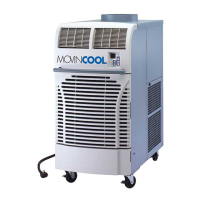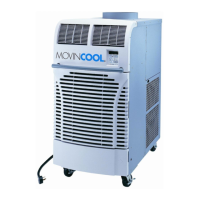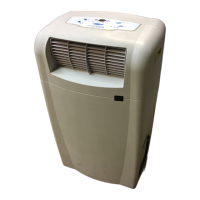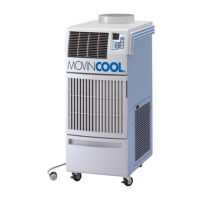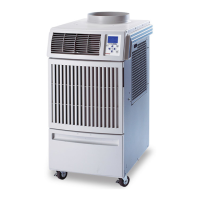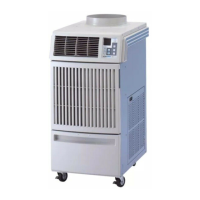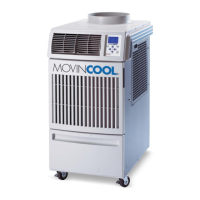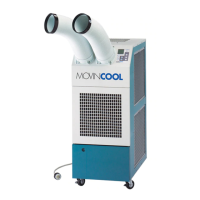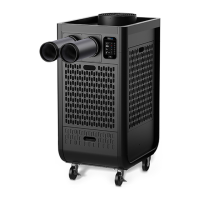What to do if Movincool Office Pro 60 Air Conditioner does not operate?
- TTom BishopJul 25, 2025
If your Movincool Air Conditioner isn't operating, you can try the following: First, reset the breaker. Second, empty the drain tank.
What to do if Movincool Office Pro 60 Air Conditioner does not operate?
If your Movincool Air Conditioner isn't operating, you can try the following: First, reset the breaker. Second, empty the drain tank.
What to do if my Movincool Air Conditioner does not operate?
If your Movincool Air Conditioner isn't turning on, check if the ground fault breaker has tripped and reset it if needed. Also, check if the drain tank is full (the FULL TANK LED will be flashing) and empty it.
Defines key terms used in the manual.
Outlines essential safety guidelines for operation and service.
Highlights the unit's integrated, space-saving construction.
Emphasizes the portability and simple setup.
Explains the unit's efficiency in targeted cooling.
Describes the unit's internal layout and components.
Details the path of air through the cooling system.
Explains the role of the compressor and fan motors.
Describes the function of the condensate removal pump.
Lists detailed technical specifications of the unit.
Provides overall physical measurements of the unit.
Presents graphs showing cooling performance under various conditions.
Displays graphs of power usage based on operating parameters.
Explains the working principle of the scroll compressor.
Describes the condenser's function as a heat exchanger.
Explains the role of capillary tubes as an expansion device.
Details the evaporator's function in cooling the air.
Describes the modulating tank's function in refrigerant quantity regulation.
Explains the function and purpose of the high pressure safety switch.
Outlines the main electrical system components and their interaction.
Describes the operation of the unit in fan-only mode.
Details the unit's operation when cooling is activated.
Explains the function and specifications of the unit's capacitors.
Describes the function and components of the relay board.
Details the specifications and function of the evaporator fan motor.
Details the specifications and function of the condenser fan motor.
Explains the specifications of the compressor motor.
Describes the function of the condensate pump.
Explains how the condensate pump collects and discharges water.
Describes the function of the drain tank switch for overflow protection.
Details the time delay program for compressor motor protection.
Explains how the microprocessor manages temperature settings.
Describes the DIP switch settings for fan operation modes.
Explains the DIP switch for Celsius/Fahrenheit display.
Checks the unit's electrical power supply.
Guides on checking and cleaning air filters.
Lists codes displayed for system diagnostics.
Provides instructions for maintaining the condensate pump.
Details the procedure for installing the condensate drain hose.
A comprehensive guide to diagnosing and resolving unit problems.
Instructions for inspecting evaporator and condenser fins.
Describes how to measure and assess cooling performance.
Provides an exploded view and overview of unit disassembly.
Step-by-step guide to removing the front panel.
Instructions for accessing internal components via panels.
Guides on removing electrical components from the control box.
Shows wiring connections for the relay board.
Illustrates wiring connections for the control board.
Details the steps for removing the blower assembly.
Instructions for removing the condenser fan motor.
Step-by-step guide for removing fan motor assemblies.
Guides on removing the evaporator fan motor.
Detailed steps for removing the main control board.
Methods for testing unit capacitors using an ohmmeter or tester.
Procedure for testing the drain switch continuity.
Resistance checks for the condenser fan motor.
Resistance checks for the evaporator fan motor.
Resistance checks for the compressor motor.
Verifies wire connections against diagrams.
Procedure to test thermistor resistance values.
Comprehensive checks for issues like clogs, leaks, or low refrigerant.
Provides guidance on proper brazing methods for repairs.
Outlines procedures for removing cycle components.
Step-by-step guide for charging the system with refrigerant.
Details the process of evacuating the refrigerant system.
Describes how to verify the system vacuum level.
Procedures for detecting leaks in the refrigerant system.
Comprehensive guide to charging the system with the correct refrigerant amount.
Instructions for correctly mounting the compressor.
Guidelines for securing wires during reassembly.
Maintenance procedures for the unit's casters.
Presents the complete electrical wiring diagram of the unit.
| Brand | Movincool |
|---|---|
| Model | Office Pro 60 |
| Category | Air Conditioner |
| Language | English |
